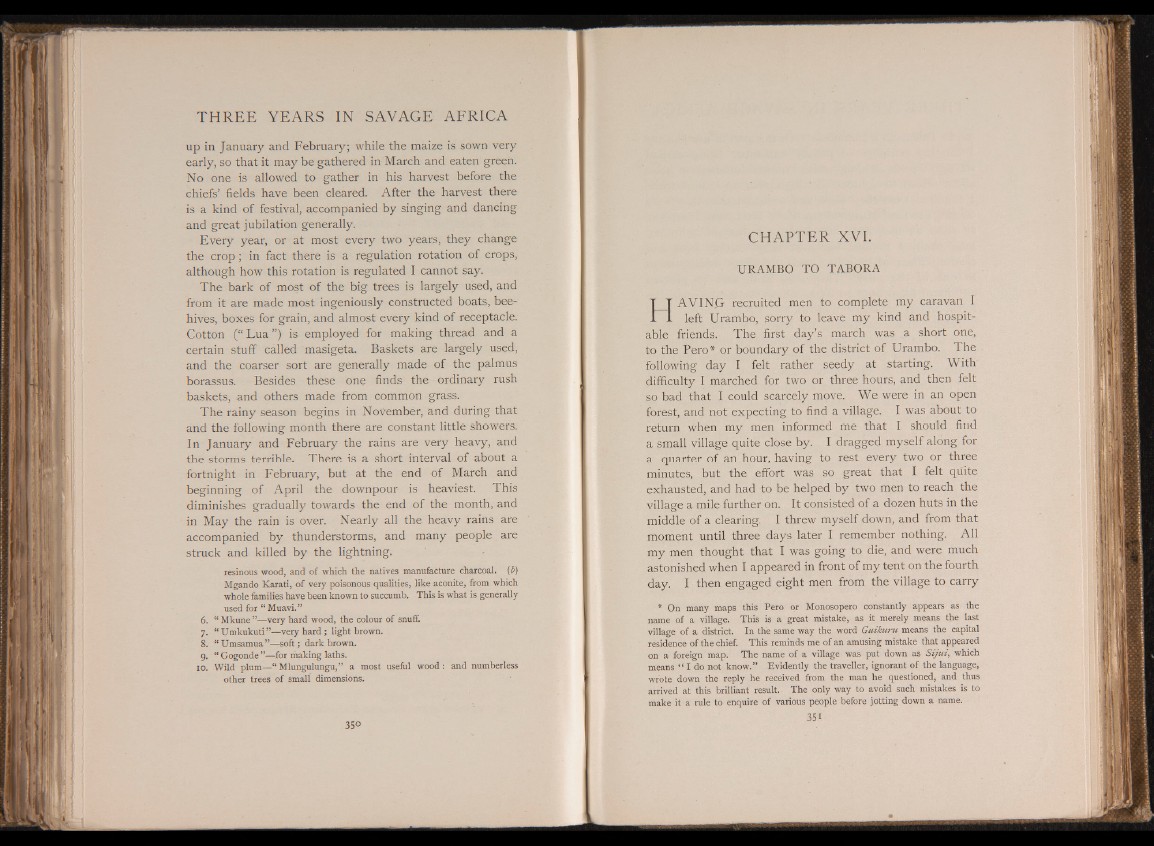
up in January and February; while the maize is sown very
early, so that it may be gathered in March and eaten green.
No one is allowed to gather in his harvest before the
chiefs’ fields have been cleared. After the harvest there
is a kind of festival, accompanied by singing and dancing
and great jubilation generally.
Every year, or at most every two years, they change
the crop; in fact there is a regulation rotation of crops,
although how this rotation is regulated I cannot say.
The bark of most of the big trees is largely used, and
from it are made most ingeniously constructed boats, beehives,
boxes for grain, and almost every kind of receptacle.
Cotton (“ Lua ”) is employed for making thread and a
certain stuff called masigeta. Baskets are largely used,
and the coarser sort are generally made of the palmus
borassus. Besides these one finds the ordinary rush
baskets, and others made from common grass.
The rainy season begins in November, and during that
and the following month there are constant little showers.
In January and February the rains are very heavy, and
the storms terrible. There is a short interval of about a
fortnight in February, but at the end of March and
beginning of April the downpour is heaviest. This
diminishes gradually towards the end of the month, and
in May the rain is over. Nearly all the heavy rains are
accompanied by thunderstorms, and many people are
struck and killed by the lightning.
resinous wood, and of which the natives manufacture charcoal, (b)
Mgando Karati, of very poisonous qualities, like aconite, from which
whole families have been known to succumb. This is what is generally
used for “ Muavi.”
6. “ Mkune ”—very hard wood, the colour of snuff.
7. “ Umkukuti ”—very hard; light brown.
8. “ Umsamua”—soft; dark brown.
9. “ Gogonde ”—for making laths.
10. Wild plum—“ Mlungulungu,” a most useful wood: and numberless
other trees of small dimensions.
C H A P T E R XVI .
U R AM BO TO T A B O R A
HAVIN.G recruited men to complete my caravan I
left Urambo, sorry to leave my kind and hospitable
friends. The first day’s march was a short one,
to the Pero* or boundary of the district of Urambo. The
following day I felt rather seedy at starting. With
difficulty I marched for two or three hours, and then felt
so bad that I could scarcely move. We were in an open
forest, and not expecting to find a village. I was about to
return when my men informed me that I should find
a small village quite close by. I dragged myself along for
a quarter of an hour, having to rest every two or three
minutes, but the effort was so great that I felt quite
exhausted, and had to be helped by two men to reach the
village a mile further on. It consisted of a dozen huts in the
middle of a clearing. I threw myself down, and from that
moment until three days later I remember nothing. All
my men thought that I was going to die, and were much
astonished when I appeared in front of my tent on the fourth
day. I then engaged eight men from the village to carry
* On many maps this Pero or Monosopero constantly appears as the
name of a village. This is a great mistake, as it merely means the last
village of a district. In the same way the word Guikuru means the capital
residence of the chief. This reminds me of an amusing mistake that appeared
on a foreign map. The name of a village was put down as S iju i, which
means “ I do not know.” Evidently the traveller, ignorant of the language,
wrote down the reply he received from the man he questioned, and thus
arrived at this brilliant result.- The only way to avoid such mistakes is to
make it a rule to enquire of various people before jotting down a name.
351